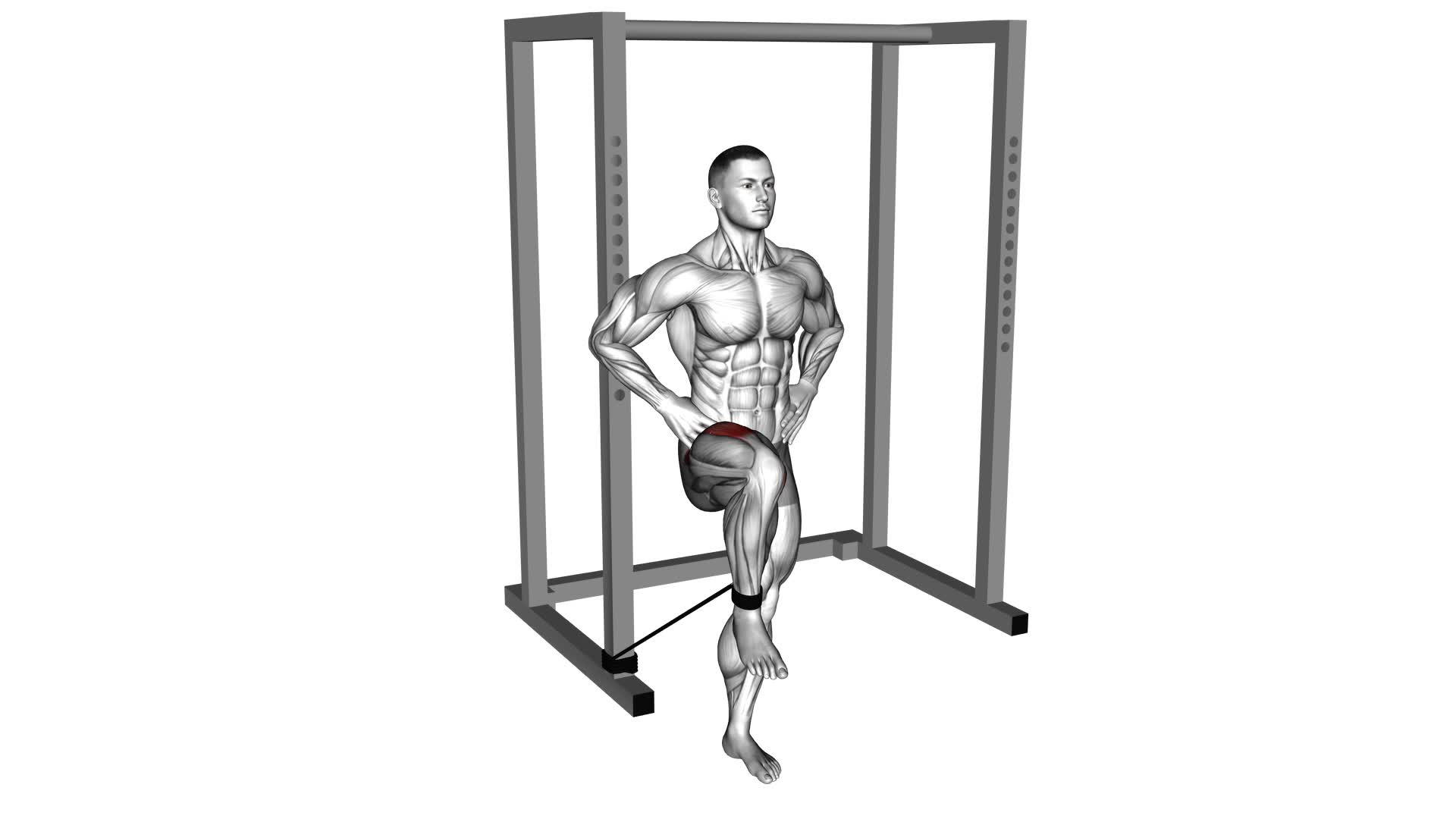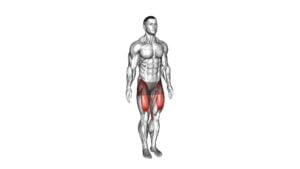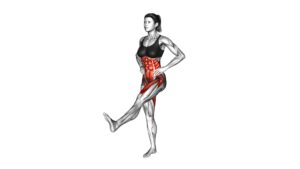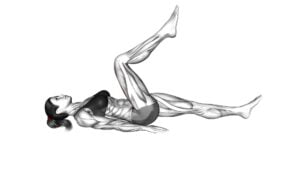Band Hip Flexion – Video Exercise Guide & Tips

Are you looking to strengthen your hip flexors? Look no further than band hip flexion exercises.
Watch This Exercise Video
This video exercise guide will show you the proper technique and form for beginner, intermediate, and advanced levels.
With just a resistance band, you can target this important muscle group and improve your overall lower body strength.
Get ready to feel the burn and maximize your workout with band hip flexion exercises.
Key Takeaways
- Band hip flexion exercises target hip flexor muscles and improve strength and flexibility.
- Proper form and control are important in band hip flexion exercises to avoid common mistakes and maximize benefits.
- Beginner, intermediate, and advanced levels of band hip flexion exercises allow for progression and increased intensity.
- Band hip flexion exercises provide overall body benefits, including core engagement, improved stability, muscle tone, and increased range of motion in the hips.
Benefits of Band Hip Flexion Exercises
Band hip flexion exercises offer numerous benefits, especially when incorporating band resistance. These exercises target the muscles of the hip flexors, which include the iliopsoas, rectus femoris, and sartorius muscles. By using a resistance band, you can add an extra challenge to your hip flexion movements, resulting in increased strength and flexibility.
One of the main benefits of band hip flexion exercises is improved hip mobility. These exercises help to increase the range of motion in your hips, which can be particularly beneficial for athletes and individuals who participate in activities that require a lot of hip movement, such as running or dancing. Additionally, band hip flexion exercises can help to alleviate tightness and stiffness in the hip flexor muscles, which can lead to improved posture and reduced lower back pain.
Furthermore, band hip flexion exercises can also help to strengthen the hip flexor muscles. The resistance provided by the band forces these muscles to work harder, resulting in increased muscle activation and strength. This can be especially beneficial for individuals who want to enhance their athletic performance or improve their overall lower body strength.
Incorporating band resistance into hip flexion exercises also allows for a variety of variations. You can perform standing band hip flexion exercises, seated band hip flexion exercises, or even lying band hip flexion exercises. These variations target the hip flexor muscles from different angles, providing a well-rounded workout for this muscle group.
Equipment Needed for Band Hip Flexion Exercises
To perform band hip flexion exercises, you'll need a resistance band. Resistance bands are versatile and affordable pieces of equipment that can be used to target various muscle groups, including the hip flexors. When selecting a resistance band, it's important to choose one that provides enough tension to challenge your muscles but still allows you to maintain proper form throughout the exercise.
Resistance bands come in different levels of resistance, usually categorized by color. Beginners may want to start with a lighter resistance band and gradually work their way up to a higher resistance as their strength and flexibility improve.
In addition to a resistance band, there are alternative exercises that can be performed to target the hip flexors. These include exercises such as leg raises, mountain climbers, and knee drives. However, using a resistance band adds an extra level of resistance, making the exercises more challenging and effective in strengthening the hip flexors.
Proper Form and Technique for Band Hip Flexion Exercises
Maintain proper form and technique while performing band hip flexion exercises to ensure maximum effectiveness and minimize the risk of injury. To achieve proper form, follow these guidelines:
- Stand with your feet shoulder-width apart and place the resistance band just above your ankles.
- Engage your core muscles and maintain a neutral spine throughout the exercise.
Common Mistakes to Avoid:
- Avoid using momentum to lift your leg. Instead, focus on using your hip flexor muscles to perform the movement.
- Don't let your knee collapse inward or rotate outward during the exercise. Keep your knee in line with your toes.
Variations to Try:
- To increase the intensity of the exercise, use a stronger resistance band or attach the band to a stable anchor point.
- If you're looking for a challenge, try performing the exercise on an unstable surface, such as a foam pad or a balance disc.
Beginner Band Hip Flexion Exercises
To progress from proper form and technique, you can begin incorporating beginner band hip flexion exercises. These exercises are designed to help you strengthen your hip flexor muscles and improve your overall hip mobility.
One beginner modification you can make is to start with a lighter resistance band. This will allow you to focus on proper form and gradually increase the intensity as you become more comfortable and confident with the exercises. Additionally, you can perform the exercises in a seated position, which can help to reduce strain on the lower back and make the movements more accessible for beginners.
When performing band hip flexion exercises, it's important to be mindful of common mistakes. One common mistake is allowing your lower back to arch excessively during the movement. To avoid this, engage your core muscles and maintain a neutral spine throughout the exercise. Another common mistake is using momentum to complete the movement instead of relying on the strength of your hip flexors. Focus on controlled, slow movements to ensure that you're effectively targeting the correct muscles.
Intermediate Band Hip Flexion Exercises
To further challenge yourself and continue building strength in your hip flexors, try incorporating intermediate band hip flexion exercises. These exercises will help you progress from the beginner level and take your hip flexion training to the next level. Here are some intermediate band hip flexion progressions to add to your routine:
- Standing Band Hip Flexion: Attach a resistance band around a stable anchor point and loop it around your ankle. Stand facing the anchor point with your feet hip-width apart. Keeping your core engaged, lift your leg forward, bringing your knee up towards your chest against the resistance of the band. Slowly lower your leg back down and repeat on the other side.
- Supine Band Hip Flexion: Lie on your back with the resistance band looped around your feet. Bend your knees and place your feet on the floor. Keeping your core engaged, lift one leg up towards your chest against the resistance of the band. Slowly lower your leg back down and repeat on the other side.
When performing these exercises, be mindful of common mistakes such as using momentum to lift your leg instead of engaging your hip flexors, or allowing your lower back to arch excessively. Focus on maintaining proper form and control throughout the movements to maximize the effectiveness of the exercises.
Advanced Band Hip Flexion Exercises
Now that you have mastered the intermediate band hip flexion exercises, it's time to take it to the next level with the advanced variations.
These exercises will challenge your hip flexors even more, allowing for greater strength and flexibility gains.
Proper Form for Hip Flexion
You should maintain proper form while performing advanced band hip flexion exercises. Proper form ensures that you target the correct muscles and reduce the risk of injury. Here are some key tips to follow:
- Alignment:
- Stand tall with your feet hip-width apart.
- Engage your core and maintain a neutral spine throughout the exercise.
- Band Placement:
- Secure the resistance band around your ankles or just above your knees.
- Make sure the band isn't too loose or too tight, allowing for controlled movement.
- Movement:
- Slowly lift one leg forward, maintaining tension in the band.
- Control the movement and avoid swinging or jerking motions.
Benefits of Hip Flexion
Engaging in advanced band hip flexion exercises offers numerous benefits for your lower body strength and flexibility. These exercises specifically target the hip flexor muscles, which are responsible for bending your hip joint and lifting your legs. By strengthening and increasing the flexibility of these muscles, you can improve your overall athletic performance and reduce the risk of injuries.
Additionally, advanced band hip flexion exercises help to improve your balance and stability, as they require proper technique and control. These exercises also engage the core muscles, further enhancing your overall body strength and stability.
Incorporating advanced band hip flexion exercises into your workout routine can help you achieve better muscle tone, improved posture, and increased range of motion in your hips.
Frequently Asked Questions
How Many Repetitions Should I Do for Band Hip Flexion Exercises?
When performing band hip flexion exercises, it's important to consider the number of repetitions. The benefits of these exercises include strengthening the hip flexor muscles and improving flexibility.
To ensure proper form, start by attaching the band to a sturdy anchor point and securing it around your ankle. Then, slowly lift your leg forward, while keeping your core engaged.
As for the number of repetitions, it's recommended to start with 8-12 reps per leg and gradually increase as your strength and endurance improve.
Can Band Hip Flexion Exercises Help Improve My Running Speed?
Band hip flexion exercises can indeed help improve your running speed. Compared to other exercises, band hip flexion exercises specifically target the muscles involved in hip flexion, which is essential for generating power and speed while running. By strengthening these muscles, you can enhance your stride length and efficiency, leading to faster running times.
Additionally, band hip flexion exercises can benefit your overall athletic performance by improving your agility, explosiveness, and stability.
Are There Any Modifications I Can Make to Band Hip Flexion Exercises if I Have Knee Pain?
If you're experiencing knee pain during band hip flexion exercises, there are modifications you can make to protect your knees.
One option is to reduce the range of motion by not bringing your knee up as high.
Another modification is to use a lighter resistance band or no band at all.
Alternatively, you can try alternative exercises that target the hip flexors without putting as much stress on the knees, such as seated leg lifts or standing hip abduction.
Can Band Hip Flexion Exercises Help With Lower Back Pain?
Band hip flexion exercises can be beneficial for improving overall mobility. By strengthening the hip flexor muscles, these exercises help to improve posture alignment, which can in turn reduce lower back pain.
The hip flexors play a crucial role in maintaining proper posture and spinal alignment. By incorporating band hip flexion exercises into your routine, you can target these muscles and promote better posture, ultimately alleviating lower back pain.
How Often Should I Incorporate Band Hip Flexion Exercises Into My Workout Routine?
To maximize the effectiveness of your workout routine, it's important to consider the frequency of incorporating band hip flexion exercises.
These exercises can be highly effective in strengthening the hip flexors and improving overall lower body stability.
In order to see progress and prevent overtraining, it's recommended to perform band hip flexion exercises 2-3 times per week.
This will allow your muscles to recover while still reaping the benefits of this targeted exercise.
Conclusion
In conclusion, band hip flexion exercises are a valuable addition to any fitness routine. They offer numerous benefits, including increased strength and flexibility in the hip flexor muscles.
By using the proper equipment and maintaining proper form and technique, individuals can progress from beginner to advanced exercises to continuously challenge and improve their hip flexion strength.
Incorporating band hip flexion exercises into your workout regimen can help enhance overall lower body strength and mobility.

Author
Years ago, the spark of my life’s passion ignited in my mind the moment I stepped into the local gym for the first time. The inaugural bead of perspiration, the initial endeavor, the very first surge of endorphins, and a sense of pride that washed over me post-workout marked the beginning of my deep-seated interest in strength sports, fitness, and sports nutrition. This very curiosity blossomed rapidly into a profound fascination, propelling me to earn a Master’s degree in Physical Education from the Academy of Physical Education in Krakow, followed by a Sports Manager diploma from the Jagiellonian University. My journey of growth led me to gain more specialized qualifications, such as being a certified personal trainer with a focus on sports dietetics, a lifeguard, and an instructor for wellness and corrective gymnastics. Theoretical knowledge paired seamlessly with practical experience, reinforcing my belief that the transformation of individuals under my guidance was also a reflection of my personal growth. This belief holds true even today. Each day, I strive to push the boundaries and explore new realms. These realms gently elevate me to greater heights. The unique combination of passion for my field and the continuous quest for growth fuels my drive to break new ground.



